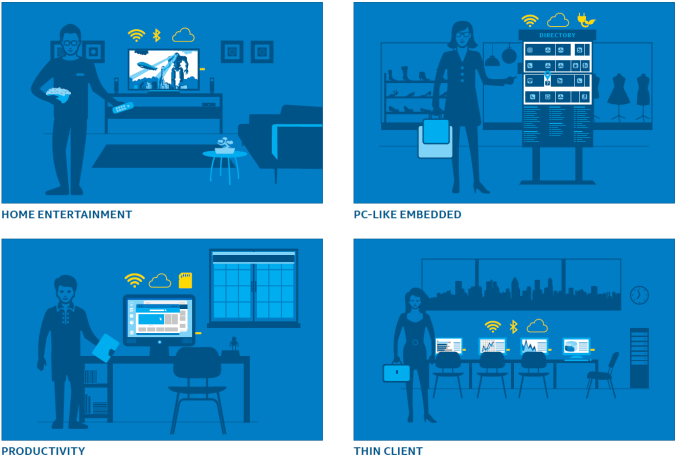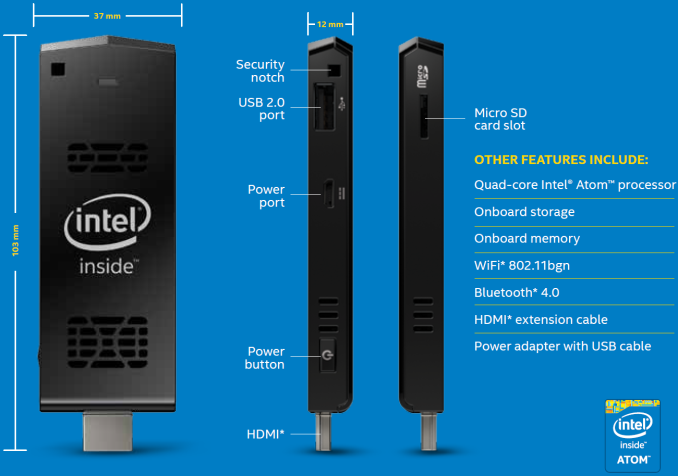Intel PPSTCK1A32WFC Bay Trail-T Compute Stick Review
by Ganesh T S on April 22, 2015 11:00 AM EST- Posted in
- Systems
- Intel
- Bay Trail
- HDMI Stick
Concluding Remarks
The Intel Compute Stick gave us the opportunity to see whether a tablet SoC could provide enough horsepower for a desktop PC. Based on our experience, the answer to that question is cautiously in the affirmative. There is no doubt that the device can do well as an economical solution for thin clients, kiosks and digital signage. These are scenarios where only one program runs for the life of the system and the OS is rarely updated.
The Compute Stick could do with some improvements for the scenarios in the left column
Traditional PCs have a different use-case compared to PC-like embedded systems and that brings us to the first problem in the Compute Stick we reviewed:
- OS drive size
32 GB, simply put, is just not enough after Windows installs a couple of updates. Out of the box, the system had around 17 GB free in the 23 GB disk (the rest, presumably, is the OS recovery partition). An initial update check resulted in a 1.3 GB download, and that installation brought down the free space to 14.3 GB. We have always been wary of Windows Updates on machines with low free space on the primary drive. As feared, attempting to install another round of updates resulted in a botched update problem (solved here). We had to spend 4+ hours getting the unit back to the initial state with a 'refresh' operation (and reinstall all the updates once again). To top it off, Windows lost activation in the refresh process and refused to reactivate (indicating a blacklisted key).
- Thermal design / solution
There is no doubt that the thermal design is very effective. Acoustic measurements come in at 28 dB at 1m distance. However, the irregular nature of the small-diameter fan makes for a strained experience if the user sits very close to the Compute Stick (possible in an office environment). It would not be a bad idea to go for a passively cooled Compute Stick at the cost of a slight increase in cost, weight and/or size.
- WLAN solution
The unit doesn't come with any wired networking facilities. It is essential that the Wi-Fi solution be top-notch. Unfortunately, a single-band 1x1 802.11n solution just doesn't cut it - particularly for scenarios involving video streaming. Thankfully, the presence of Bluetooth makes a USB keyboard / mouse unnecessary, freeing up the single USB 2.0 port for other purposes. Talking of video streaming, it would also be nice to have full HD audio support in the GPU drivers for Bay Trail-T (now that it has made its appearance in a mini-PC).
Despite the above shortcomings, the Compute Stick did impress us in a few areas - the form factor and portability aspects are praiseworthy. The CPU performance is not as bad as we feared it would be - Windows loads in a smooth manner and the system is as responsive as what one can expect from a Bay Trail-based mini-PC.
Coming to the business end of the review, we can say that the Intel Compute Stick is a typical first-generation product. In our opinion, there are way too many compromises being made to get to this form factor. There are certainly applications where the kit would be perfect, but general-purpose day-to-day computing is not one of them. If Intel wants the Compute Stick product line to take off like NUCs, addressing the three main shortcomings detailed above would be a good first step.












103 Comments
View All Comments
azazel1024 - Wednesday, April 22, 2015 - link
Also, PS where the heck is the Airmont architectual review and Surface 3 review? I feel like Anand had a Silvermont arch review within a couple of weeks (+/-) of Bay Trail being released and even a preview one a couple of months before. I have seen nada on Airmont so far and a couple of reviews of the surface 3 from othersites a couple of days ago.kyuu - Thursday, April 23, 2015 - link
Yeah I'm definitely missing the indepth reviews of new processors. Hopefully that's not something that has gone away with Anand's departure.tuxRoller - Thursday, April 23, 2015 - link
I run plex on a local machine along with bubble. Those two handle pulling in various streams and transcoding everything properly to the chromecast.Xpl1c1t - Wednesday, April 22, 2015 - link
14nm. Sure will be better!maxxbot - Wednesday, April 22, 2015 - link
Chromecast only does one very specific thing while this is a general purpose machine, the two products are not comparable at all.close - Thursday, April 23, 2015 - link
Why not compare it with a Kindle? Which also has a screen so it must be better...duploxxx - Thursday, April 23, 2015 - link
have ugoos m2 for about a year now, half the price, 1/4 power consumption. full XBMC support.x86 is useless in uber small form factor
Jumangi - Thursday, April 23, 2015 - link
Chromecast? This is a fully working PC. Have you heard the phrase Apple and Oranges?Marthisdil - Friday, April 24, 2015 - link
Except Chromecast isn't a valid comparison. Chromecast doesn't do anything...It's a neat tool for casting from a computer or mobile device to your tv...but that's about all it does.
the comparison isn't valid
Jumangi - Thursday, April 23, 2015 - link
They got a fully working windows machine onto a USB sized stick for $150 that includes Windows. That it works at all is impressive.